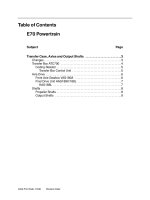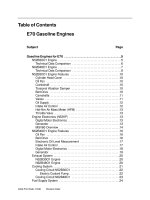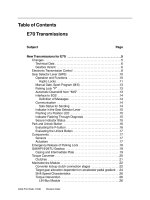C476 02
Bạn đang xem bản rút gọn của tài liệu. Xem và tải ngay bản đầy đủ của tài liệu tại đây (26.28 KB, 3 trang )
Designation: C 476 – 02
Standard Specification for
Grout for Masonry1
This standard is issued under the fixed designation C 476; the number immediately following the designation indicates the year of
original adoption or, in the case of revision, the year of last revision. A number in parentheses indicates the year of last reapproval. A
superscript epsilon (e) indicates an editorial change since the last revision or reapproval.
This standard has been approved for use by agencies of the Department of Defense.
3.1.1.1 Portland Cement—Type I, IA, II, IIA, III, and IIIA
of Specification C 150.
3.1.1.2 Blended Cements—Type IS, IS(MS), IS-A, ISA(MS), IP, or IP-A of Specification C 595 or types GU, HE,
MS, or HS of Specification C 1157.
3.1.1.3 Quicklime—Specification C 5.
3.1.1.4 Hydrated Lime—Type S of Specification C 207.
3.1.1.5 Coal Fly Ash or Raw Calcined Natural Pozzolan—
Specification C 618. Addition rates shall be in an amount
governed by the portland-pozzolan cement category of Specification C 595. The grout produced with blends of portland
cement and fly ash or raw calcined natural pozzolan shall have
the compressive strength specified (4.2.2).
3.1.1.6 Granulated Blast Furnace Slag—Specification C
989. Addition rates shall be as governed by the portland blast
furnace slag cement category of Specification C 595. Grouts
produced with blends of portland cement and granulated blast
furnace slag shall have the compressive strength specified
(4.2.2).
3.1.2 Air-Entraining Admixtures—Air-entraining admixtures shall conform to Specification C 260.
3.1.3 Aggregates—Aggregates shall conform to Specification C 404.
3.1.4 Water—Water shall be clean and potable.
3.1.5 Admixtures—Integral waterproofing compounds, accelerators, or other admixtures not mentioned definitely in the
specification shall not be used in grout for use in reinforced
masonry without approval from the purchaser.
3.1.6 Pumping Aids—Pumping aids are permitted to be used
in cases where the brand, quality, and quantity are approved in
writing by the purchaser or are definitely stipulated in the
specification.
3.1.7 Antifreeze Compounds—No antifreeze liquids, salts,
or other substances shall be used in grout to lower the freezing
point.
3.1.8 Storage of Materials—Cementitious materials and
aggregates shall be stored in such a manner as to prevent
deterioration or intrusion of foreign material or moisture. Any
material that has become unsuitable for good construction shall
not be used.
1. Scope *
1.1 This specification covers two types of grout, fine and
coarse grout, for use in the construction of masonry structures.
Grout is specified by (1) proportions or (2) strength requirements.
1.2 The text of this specification references notes and
footnotes that provide explanatory material. These notes and
footnotes (excluding those in tables and figures) shall not be
considered as requirements of this specification.
2. Referenced Documents
2.1 ASTM Standards:
C 5 Specification for Quicklime for Structural Purposes2
C 143/C 143M Test Method for Slump of HydraulicCement Concrete3
C 150 Specification for Portland Cement2
C 207 Specification for Hydrated Lime for Masonry Purposes2
C 260 Specification for Air-Entraining Admixtures for Concrete3
C 404 Specification for Aggregates for Masonry Grout4
C 595 Specification for Blended Hydraulic Cements2
C 618 Specification for Coal Fly Ash and Raw or Calcined
Natural Pozzolan for Use as a Mineral Admixture in
Concrete2
C 989 Specification for Ground Granulated Blast-Furnace
Slag for Use in Concrete and Mortars3
C 1019 Test Method for Sampling and Testing Grout4
C 1157 Performance Specification for Hydraulic Cement2
3. Materials
3.1 Materials used as ingredients in grout shall conform to
the requirements specified in 3.1.1-3.1.8.
3.1.1 Cementitious Materials—Cementitious materials shall
conform to one of the following specifications:
1
This specification is under the jurisdiction of ASTM Committee C12 on
Mortars and Grouts for Unit Masonryand is the direct responsibility of Subcommittee C12.05 on Grout and Grout Admixtures for Masonry.
Current edition approved August 10, 2002. Published September 2002. Originally published as C 476–61T. Last previous edition C 476–02.
2
Annual Book of ASTM Standards, Vol 04.01.
3
Annual Book of ASTM Standards, Vol 04.02.
4
Annual Book of ASTM Standards, Vol 04.05.
NOTE 1—If the grout is to be used to bond masonry units to reinforcing
bars, the use of air-entraining materials or air-entraining admixtures is not
recommended.
*A Summary of Changes section appears at the end of this standard.
Copyright © ASTM International, 100 Barr Harbor Drive, PO Box C700, West Conshohocken, PA 19428-2959, United States.
1
C 476 – 02
directions. All quicklime putty, except pulverized quicklime putty, should be sieved
through a No. 20 (850-µm) sieve and allowed to cool until it has reached a
temperature of 80°F (26.7°C). Quicklime putty should weigh at least 80 lb/ft3 (281
kg/m3). Putty that weighs less than this may be used in the proportions specifications if the required quantity of extra putty is added to meet the minimum weight
requirements.
4. Grout Type and Proportions
4.1 Type—Grout type shall be specified as fine or coarse.
4.1.1 Fine grout shall be manufactured with fine aggregates.
4.1.2 Coarse grout shall be manufactured with a combination of coarse and fine aggregates.
5.2 Production Methods—Grout shall be produced using
one of the following procedures:
5.2.1 Materials Mixed at Job Site:
5.2.1.1 Individual cementitious materials and aggregates
stored at the job site shall be mixed in a mechanical mixer for
a minimum of 5 min with sufficient water to achieve the
desired consistency.
5.2.1.2 Individual dry ingredients transported to the job site
in suitable compartments shall be mixed with water at the job
site using continuous volumetric proportioning equipment to
achieve the desired consistency. Mix with an auger of appropriate length to provide adequate mixing.
5.2.2 Mixed Materials Transported to the Job Site:
5.2.2.1 Factory dry-blended cementitious materials and aggregates delivered to the job site shall be mixed in a mechanical mixer for a minimum of 5 min with sufficient water to
achieve the desired consistency.
5.2.2.2 Wet-mixed grout shall arrive at the job site in a
ready-mixed condition. Slump shall be adjusted as necessary,
and grout shall be re-mixed at mixing speed for at least 1 min
before discharging to achieve the desired consistency.
NOTE 2—Building code provisions and grout space dimensions should
be reviewed when selecting grout type or types.
4.2 Proportions of Ingredients—Grout proportions shall be
determined by one of the following methods:
4.2.1 Requirements of Table 1.
4.2.2 Specified Compressive Strength—Proportions established by 28–day compressive strength tests in accordance with
Test Method C 1019 that obtain the specified compressive
strength. The grout shall be mixed to a slump of 8 to 11 in. (200
to 280 mm) as determined by Test Method C 143/C 143M and
shall have a minimum compressive strength of 2000 psi (14
MPa) at 28 days.
NOTE 3—Building code provisions should be reviewed when selecting
the specified compressive strength of grout.
5. Measurement and Production
5.1 Measurement of Materials—Measure materials for
grout such that the required proportions of the grout materials
are controlled and accurately measured.
NOTE 4—When converting volume proportions to batch weights, use
the following material bulk densities:
Weight, lb/ft3(kg/m3)
94 (1505)
Obtain from bag or supplier
Obtain from bag or supplier
40 (640)
80 (1280)
80 (1280) of dry sand
Refer to C 404 to determine weight per cubic
foot.
Material
Portland cement
Blended cement
Other cementitious materials
Hydrated lime
Lime puttyA
Sand, damp and loose
Coarse aggregate
A
NOTE 5—Grout may be hand mixed on small jobs with written approval
of the mixing procedure by the specifier.
6. Keywords
6.1 aggregates; cement; compressive strength; grout; masonry; portland cement; proportions
All quicklime should be slaked in accordance with the manufacturer’s
SUMMARY OF CHANGES
Committee C12 has identified the location of selected changes to this standard since C 476–01 that may impact
the use of this standard.
(1) Revised Note 4.
TABLE 1 Grout Proportions by Volume
Type
Parts by Volume of
Portland Cement or
Blended Cement
Parts by Volume of
Hydrated Lime or Lime
Putty
Aggregate,
Measured in a Damp, Loose Condition
Fine
Fine grout
1
0– ⁄
Coarse grout
1
0–1⁄10
2 ⁄ –3 times the sum of the
volumes of the cementitious
materials
1
2 ⁄4–3 times the sum of the
volumes of the cementitious
materials
1 10
14
2
Coarse
...
1–2 times the sum of the
volumes of the cementitious
materials
C 476 – 02
ASTM International takes no position respecting the validity of any patent rights asserted in connection with any item mentioned
in this standard. Users of this standard are expressly advised that determination of the validity of any such patent rights, and the risk
of infringement of such rights, are entirely their own responsibility.
This standard is subject to revision at any time by the responsible technical committee and must be reviewed every five years and
if not revised, either reapproved or withdrawn. Your comments are invited either for revision of this standard or for additional standards
and should be addressed to ASTM International Headquarters. Your comments will receive careful consideration at a meeting of the
responsible technical committee, which you may attend. If you feel that your comments have not received a fair hearing you should
make your views known to the ASTM Committee on Standards, at the address shown below.
This standard is copyrighted by ASTM International, 100 Barr Harbor Drive, PO Box C700, West Conshohocken, PA 19428-2959,
United States. Individual reprints (single or multiple copies) of this standard may be obtained by contacting ASTM at the above
address or at 610-832-9585 (phone), 610-832-9555 (fax), or (e-mail); or through the ASTM website
(www.astm.org).
3









